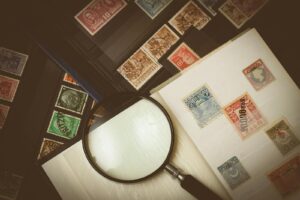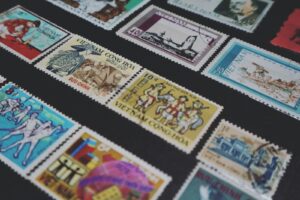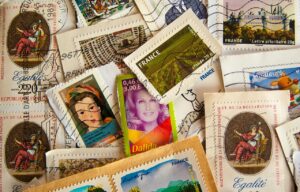Imagine delving into the vibrant world of collecting stamps, where every tiny piece of paper tells a story of distant lands, historical events, and artistic expressions. Whether you’re a seasoned philatelist or just starting, the hobby of stamp collecting offers a unique blend of history, art, and culture, making it a fascinating pursuit for people of all ages.
As you step into this intriguing world, you’ll discover that collecting stamps isn’t just about preserving postage; it’s about capturing moments in time and exploring the world from the comfort of your home. From rare finds to the thrill of completing a series, the joys of stamp collecting are endless and deeply rewarding.
Get ready to embark on a journey through time and across continents without leaving your doorstep. Stamp collecting isn’t merely a hobby—it’s a gateway to a richer understanding of the world. Let’s explore what makes this timeless hobby a continuous source of fascination and delight.
Benefits of Stamp Collecting
Educational Value
Stamp collecting enriches your knowledge across numerous fields such as geography, history, and the arts. Each stamp represents a unique element of the global mosaic, offering insights into different cultures and historical epochs. For example, collecting stamps depicting former presidents can deepen your understanding of political history, while stamps from different countries provide a view into international customs and landmarks.
Financial Investment
Some stamps, especially rare and unused ones, can significantly increase in value over time. By maintaining a well-preserved stamp collection, you’re not just indulging in a hobby but potentially securing an investment that could yield financial benefits. Stamp collectors often use albums and acid-free paper to ensure the longevity and mint condition of their collections, which in turn supports the preservation of the collection’s value.
Social Connection
Being part of a stamp collecting community can lead to forming meaningful connections with like-minded individuals. Local stamp clubs and stamp fairs serve as great venues to meet other collectors and exchange both stamps and stories. These gatherings can help expand your collection and understanding of philately, fostering friendships that share a common interest in this timeless hobby.
A Brief History of Stamps
Stamps, as a cornerstone of postal history, began with the introduction of the “Penny Black” in 1840 by the United Kingdom. This innovation marked the beginning of prepaid postage, a concept that was revolutionary at the time and catalyzed the global adoption of similar systems. The Penny Black featured a profile of Queen Victoria and set a standard for future stamps’ use and collectability.
The expansion of stamp use quickly followed, fostering a new hobby—philately. Not only did stamps become a practical postal necessity, they also caught the attention of collectors. By the late 19th century, thousands of unique stamps were produced by post offices around the world, each telling its own story about the culture, history, or political climate of its country of origin. These myriad designs, from depictions of national leaders to commemorations of significant events, turned stamp collections into miniature encyclopedias of world history and art.
As the hobby of collecting stamps, or philately, grew in popularity, so did the infrastructure supporting it. Stamp albums and catalogues were developed to assist collectors in organizing and displaying their collections. Local stamp clubs and international fairs began to spring up, offering spaces where like-minded enthusiasts could share their passion, trade duplicates, and acquire rare finds. This social aspect of stamp collecting helped to establish a community of collectors who not only appreciate the aesthetic and historical significance of stamps but also enjoy the pursuit as a shared endeavor.
Essential Terms Every Collector Should Know
Philately
Philately, much more than simple “stamp collecting,” is the structured study of stamps and postal history. It dives deep into the examination of not just the stamp design, but also its issue, usage, and relevance within postal history. As a philatelist, you’ll explore aspects such as watermark detection, the measurement of perforations, and the identification of any original gum on unused stamps. To facilitate this, tools like a magnifying glass and a perforation gauge become essential.
Stamp Catalogue and Stamp Album
Your stamp catalogue is a vital tool, functioning as the encyclopedia for your collection. It provides detailed information about each stamp including the year of issue, origin country, and historical context. Meanwhile, preserving your collection appropriately involves the use of a stamp album. Opt for acid-free paper to safeguard the stamps from degradation. Stamp albums not only organize your collection but also help in displaying them in an appealing way that highlights their design and historical value.
Essentials for Handling Stamps
Careful handling is paramount in stamp collecting to maintain the condition of your stamps. Stamp tongs help prevent the transfer of oil and dirt from your fingers to the stamp, which could degrade the adhesive or the paper. Additionally, if you’re dealing with used stamps, soaking methods using cool water are crucial for removing them from envelopes without damage. For mounting, choose stamp mounts or stamp hinges to affix your stamps in your album, ensuring they remain in mint condition without direct contact to the adhesive.
By familiarizing yourself with these terms and tools, you’ll enhance not only your collection’s value but also your enjoyment and expertise in this refined hobby.
Choosing Your Stamp Collection Focus
As you delve deeper into the hobby of stamp collecting, choosing a specific focus for your collection can significantly enhance your experience and expertise. This section will help you determine the right path for your philatelic interests based on various types of stamps and thematic choices.
Types of Stamps to Collect
Your journey into stamp collecting offers many avenues, depending on your interests. You might opt for postage stamps, which are commonly used for mailing letters and packages. These can be either used stamps, which show marks or cancellation from a post office, or unused stamps, which retain their original adhesive and are generally more valuable. Another intriguing option is collecting revenue stamps.
Unlike postage stamps, these are used to collect taxes or fees on items ranging from documents to tobacco and alcohol. Collecting specific types such as commemorative stamps, issued to honor significant events, personalities, or anniversaries, can also be particularly rewarding. Each type not only reflects its aesthetic and historical value but also brings a unique story into your collection.
Choosing Themes and Countries
Selecting a theme or a specific country for your stamp collection can provide a meaningful direction to your hobby. Themes can vary widely; you might be captivated by stamps featuring natural landscapes, renowned personalities, important historical milestones, or artworks. For instance, if you’re fascinated by nature, stamps depicting flowers, wildlife, or national parks will make an excellent theme for your collection.
Alternatively, if focusing on a specific country’s stamps, this allows you to dive deep into the historical and cultural background of a place, enriching your knowledge as a philatelist. Countries like the United Kingdom, which issued the world’s first adhesive postage stamp, the Penny Black, or China, with its intricate designs and historical significance, can offer particularly enriching collections. By choosing a theme or country, you not only streamline your collecting efforts but also build a collection that’s both personal and profound in its narrative.
Starting Your Stamp Collection
Starting your stamp collection can be an exciting journey into history, culture, and art through the miniature canvases of stamps. If you’ve found yourself fascinated by philately, or stamp collecting, setting up your collection properly from the beginning enhances both its value and your enjoyment.
Acquiring Your First Stamps
Embarking on your philatelic journey begins with acquiring your first stamps. You can purchase stamps through various channels: local stamp dealers, stamp fairs, and online auctions are excellent starting points to find unique and desirable pieces for your collection. Stamp dealers often provide valuable insights and can help you understand the nuances of condition and rarity. Beginning with stamps from a specific country or theme that you’re passionate about, such as historical events or natural flora and fauna, can provide focus and enjoyment. Alternatively, you may choose to buy starter packs from local post offices; these often include a variety of unused stamps which are perfect for beginners.
Tools Needed for Collecting
The right tools are essential in maintaining the condition and organization of your stamp collection. Essential items include stamp tongs, which help you handle stamps without damaging them, and a magnifying glass, crucial for examining intricate details and verifying authenticity. To properly store your stamps, invest in a high-quality stamp album and acid-free paper to prevent degradation over time. For those interested in precision, a perforation gauge helps you measure and catalog your stamps accurately. These tools not only preserve the quality and longevity of your collection but also enhance your collecting experience by ensuring your stamps are well-protected and displayed beautifully.
Caring for Your Stamp Collection
Maintaining the condition of your stamp collection guarantees the enduring value and enjoyment of your hobby. Caring for your stamps involves more than just keeping them; it’s about preserving history and your personal connection to this captivating pursuit.
Proper Storage Techniques
Selecting the right storage for your stamp collection is crucial to prevent damage and deterioration. Begin by using stamp albums or stock books that are specifically designed to house stamps. Ensure that these storage solutions are made of acid-free paper, as it won’t harm the original gum of unused stamps or affect the colors and materials of used stamps. Opt for stamp mounts or stamp hinges to secure your stamps in the album. These tools hold your stamps without causing adhesive damage or other harm, preserving the integrity of the stamp’s design.
Handling and Preservation Tips
When handling stamps, always use stamp tongs. These specialized tools help you grip stamps without the risk of transferring oil or dirt from your fingers onto the delicate paper. It’s also important to operate in a clean, dry area to avoid accidental exposure to moisture, which can activate gum on unused stamps and potentially ruin them. If your stamps are exposed to moisture or become sticky, lightly moisten them with cool water and allow them to dry on acid-free paper. This method helps preserve the adhesive qualities of the gum without causing unnecessary pull on other items within your collection.
Final Thoughts
Embarking on the journey of stamp collecting can be a fascinating and rewarding hobby. By understanding the basics and employing the right tools and techniques you’ve learned, you’re well-equipped to start or enhance your collection. Whether you’re drawn to the historical significance of stamps or the joy of finding that rare piece it’s clear that this hobby offers something for everyone. Remember to stay patient and organized as your collection grows and transforms into a personal archive of history and art.
Other suggested articles:



